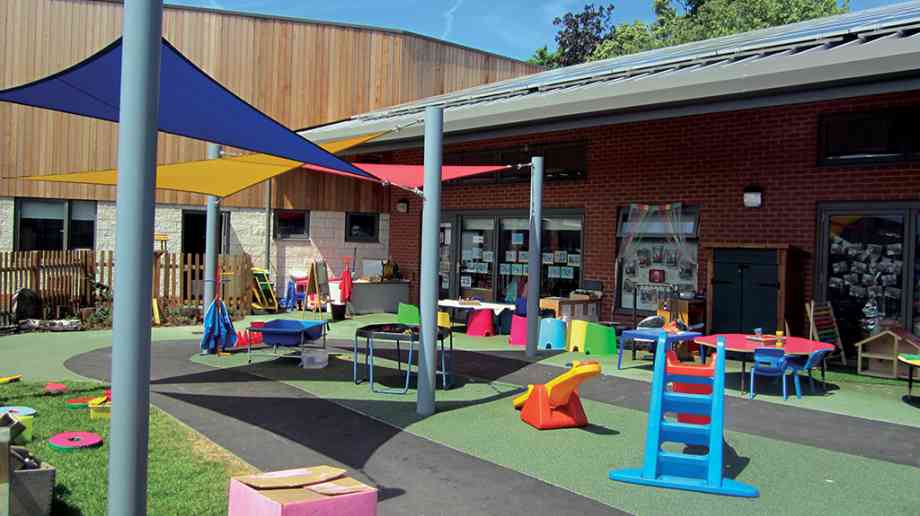
The space to learn and grow
Denise Ewbank from the British Association of Landscape Industries (BALI) considers how schools can be innovative in the use of their outdoor space to enable children to learn and grow
Back in the early sixties I attended my local North London primary school – all red brick, tall windows, asphalt playground complete with hopscotch markings, and what seemed like an endless school playing field.
The field was surrounded by horse chestnut trees, which each autumn delivered the most enormous conkers for hard fought conker fights – no-one had heard of risk assessments then. Whilst most of our lessons were, I recall, indoors, I distinctly remember during the summer term weekly storytelling sat under those glorious trees. Playtimes were spent belting around the playground, letting off steam, and huddling in friendship groups that changed with the wind.
The point is, I remember very little of the indoor space of either my primary or senior schools but I do remember the grounds of both and the experiences – play, learning, sporting achievement – enjoyed in them.
’NOWHERE TO PLAY
This April, the Association of Play Industries (API) published its report on the current state of playground provision in England – ‘Nowhere to Play’ (api-play.org/news/nowhere2play‑campaign).
It bemoans the fact that local authorities faced with crippling budget cuts are closing public playgrounds at an alarming rate – over 200 have already been closed and a further 200+ are earmarked for closure.
The report’s opening paragraph states what we all know to be true: “Play is vital to a child’s wellbeing and development through their formative years. It is through play and activity that children learn to engage and interact with the world around them. Much has been written about the benefits of play on children’s happiness, physical activity, cognitive skills, social and emotional learning, and it is now seen as fundamental to a happy childhood.”
If children are denied access to play and learning experiences in the public realm then it is even more important that their school environment delivers opportunities to learn and grow outdoors.
Members of the British Association of Landscape Industries (bali.org.uk) – landscapers and designers, grounds maintenance contractors, and suppliers of industry-related products and services – are working with schools across the country to ensure their grounds are used to their full potential within the necessary constraints of the school’s grounds maintenance or project-based budgets.
Play areas with colourful safety surfacing, timber play structures, and installations that challenge children visually, physically and emotionally, in terms of problem solving and working as part of a team, are replacing the soulless asphalt playgrounds of my youth.
TRANSFORMING SCHOOL GROUNDS
Award-winning BALI-registered contractor Ground Control Ltd (ground-control.co.uk) based in Billericay, Essex, has earned a reputation for transforming school grounds to create exciting play and learning environments.
At Hermitage Primary School in Uxbridge, Ground Control designed and created a new and engaging play space for pupils of the school, including an outdoor learning zone.
The scheme included a range of features designed to brighten the environment and engage the children. One of the features is hard surfacing – new resin bound and self‑binding surfacing was installed at the school entrance and in the outdoor classroom areas amongst existing trees, providing a warm and naturalistic character to the school’s frontage.
The main play areas feature a range of play surfaces for differing play value including a bike track from contrasting coloured surfacing and a mix of wet pour and artificial grass surfacing amongst the new play equipment and shade sails.
MUGA, a new polymeric multi-use games area with rebound fencing was installed, set into the bank of the site and marked out for football, netball and basketball. In addition to this an early years play area was installed, which included a new bike track, grass play area, and multi-coloured shade canopy providing an engaging play setting.
A playground was also put in place, incorporating a large, open ‘run and play’ area. It also features a large, bespoke climbing tower and a series of coloured shade sails that provide different break-out areas for the children.
There is also a willow tunnel, bug hotels and wildlife-friendly planting. Not only this, an outdoor learning area was added, set amongst the shelter of the existing mature trees on site, this area involved the creation of new mounds, seating and planting areas, utilising a mix of planting to provide seasonal and sensory interest.
Soft landscaping was also used – the boundaries of the site include wildflower mixes to create a buffer and wildlife area to the edges of the sports field, and a new orchard. Surrounding the play areas, the planting provides seasonal structure and a range of forms, including a herb bed and more plants designed to be touched, smelt and heard, with selection appropriate for the school setting – so nothing poisonous or spiky.
STEM
The practice of using outdoor space to facilitate the teaching of STEM subjects is increasingly widespread and providing areas for outdoor lessons and storytelling, where the ‘green’ environment has such an impact on wellbeing, is vital – it is good for the student and the teacher.
The impact on health and wellbeing from having plants in offices, and in hospitals where recovery times are hastened in patients with access to plants or simply with a view of a green landscape, is well documented. Using the great outdoors as a learning environment makes complete sense.
Whilst BALI contractors are busy adding value to their services by creating wildlife ponds and hibernacula (refuges for reptiles and amphibians), installing bird boxes and insect hotels, and sowing wildflower areas for their school clients, they are also increasingly being asked to construct raised vegetable beds and greenhouses so that children can learn about the food they eat, how to grow it and then how to cook it.
GARDENING
The RHS Campaign for School Gardening (schoolgardening.rhs.org.uk) supports schools to give children gardening opportunities and to develop sustainable gardens within the school environment.
Registration is free and a welcome pack provides seeds, plant labels, stickers, posters, and much more.
This campaign is important, not least because the horticulture and landscape industry is suffering from a crippling skills shortage. Not enough young people are coming into the industry – and this threatens a sector that contributes £10.4 billion to GDP.
BALI has over 900 members and these businesses will be seriously compromised if the supply of skilled young people choosing the landscape industry as a career path is not increased markedly.
BALI’s GoLandscape initiative is designed to promote the landscape industry to school children, and their parents and teachers, from Year 9 onwards. A comprehensive, interactive website at golandscape.co.uk provides information on the many career opportunities, from landscape operative to landscape architect.
It carries case studies about real people working in the industry, and lists the qualifications and career paths open to those who want to work in designing, building or maintaining our cherished landscapes.
GoLandscape Ambassadors – BALI members with many years of industry
experience – are available to talk to school groups and attend career fairs to introduce the landscape industry as a real career option.
It was BALI members who built the Queen Elizabeth Olympic Park – the largest urban park in Europe and the largest to be built in the UK for over a century – and our members who now maintain it into legacy.
Children should know, as they learn and grow, that they, too, through their career choice, can play a part in providing a landscape legacy. Learning outdoors from an early age is an important step in developing that love of our outdoor environment.
further information
www.bali.org.uk
Latest News
14/11/2025 - 11:04
England’s councils are warning of a "ticking time bomb" in the special educational needs and disabilities (SEND) system, with new data showing deficits that could bankrupt local authorities within three years.
13/11/2025 - 12:14
Event for school leaders, governors and education professionals relocates to the historic Old Billingsgate venue in London.
13/11/2025 - 09:49
The regulations have been set following a second consultation and detailed collaborative working with organisations and people across deaf and hearing communities.
13/11/2025 - 09:39
The Education Committee has published a letter to the Secretary of State for Education asking for more detail about the Department for Education’s work on developing its SEND reforms.
13/11/2025 - 09:26
New analysis by NFER has highlighted the uneven distribution of pupils with special educational needs and disabilities (SEND) across mainstream schools in England.







